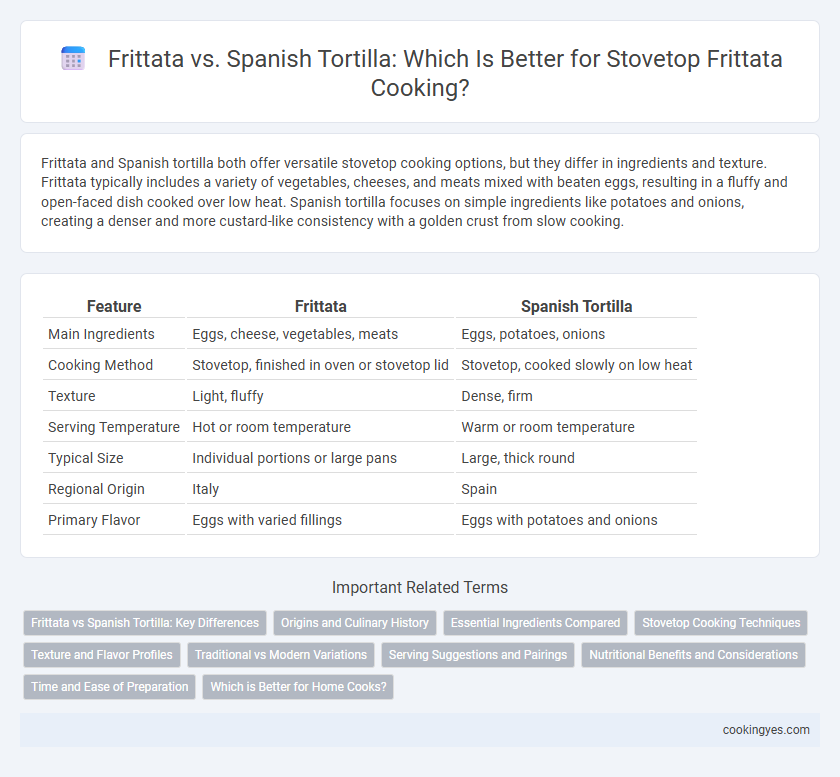Frittata and Spanish tortilla both offer versatile stovetop cooking options, but they differ in ingredients and texture. Frittata typically includes a variety of vegetables, cheeses, and meats mixed with beaten eggs, resulting in a fluffy and open-faced dish cooked over low heat. Spanish tortilla focuses on simple ingredients like potatoes and onions, creating a denser and more custard-like consistency with a golden crust from slow cooking.
Table of Comparison
| Feature | Frittata | Spanish Tortilla |
|---|---|---|
| Main Ingredients | Eggs, cheese, vegetables, meats | Eggs, potatoes, onions |
| Cooking Method | Stovetop, finished in oven or stovetop lid | Stovetop, cooked slowly on low heat |
| Texture | Light, fluffy | Dense, firm |
| Serving Temperature | Hot or room temperature | Warm or room temperature |
| Typical Size | Individual portions or large pans | Large, thick round |
| Regional Origin | Italy | Spain |
| Primary Flavor | Eggs with varied fillings | Eggs with potatoes and onions |
Frittata vs Spanish Tortilla: Key Differences
Frittata and Spanish tortilla are both stovetop egg dishes but differ significantly in ingredients and texture. Frittata incorporates a variety of fillings like vegetables, cheese, and meats, cooked slowly and often finished in the oven, resulting in a fluffy and open-faced dish. Spanish tortilla, primarily made with eggs, potatoes, and onions, is thicker, denser, and cooked entirely on the stovetop with a characteristic golden crust.
Origins and Culinary History
Frittata, originating from Italy during the Renaissance, emphasizes whisked eggs combined with various vegetables, meats, and cheeses, cooked slowly on the stovetop or finished in an oven. The Spanish Tortilla, or Tortilla Espanola, dates back to 19th-century Spain, traditionally consisting of eggs, potatoes, and onions, reflecting its origins as a simple peasant dish. Both dishes highlight regional culinary techniques and ingredients but differ in texture and preparation, with the frittata being fluffier and the tortilla more dense and compact.
Essential Ingredients Compared
Frittata typically contains eggs, cheese, vegetables, and sometimes meats like bacon or sausage, offering a creamy texture and rich flavor. Spanish Tortilla primarily consists of eggs, thinly sliced potatoes, and onions, cooked slowly to develop a dense, hearty consistency. Both dishes rely on eggs as a base but differ significantly in ingredient composition and flavor profiles, influencing stovetop cooking techniques and final taste.
Stovetop Cooking Techniques
Stovetop cooking techniques for frittata and Spanish tortilla both emphasize even heat distribution and low to medium temperature to ensure thorough cooking without burning. Frittatas typically start with sauteed ingredients, then beaten eggs poured over and gently cooked before finishing under a lid or in the oven, promoting a custard-like texture. Spanish tortilla requires slow cooking thinly sliced potatoes and onions in olive oil until tender, then combining with eggs and cooking slowly to develop a dense yet creamy interior.
Texture and Flavor Profiles
Frittata features a fluffy, creamy texture with a rich, egg-forward flavor enhanced by added vegetables and cheeses, while Spanish Tortilla boasts a denser, more uniform texture due to its predominant use of thinly sliced potatoes and onions. The frittata's open-faced style allows for varied mix-ins, resulting in a versatile and layered taste experience. In contrast, the Spanish Tortilla delivers a hearty, savory profile with caramelized sweetness from slow-cooked onions and potatoes, creating a satisfying, rustic dish.
Traditional vs Modern Variations
Frittata and Spanish tortilla differ significantly in stovetop cooking techniques and ingredient choices, with the traditional Spanish tortilla emphasizing simple ingredients like potatoes, eggs, and onions cooked slowly for a tender texture, while modern frittata variations incorporate diverse vegetables, cheeses, and meats for enhanced flavor complexity. Traditional Spanish tortilla relies on precise temperature control to achieve a custardy center, contrasting with frittatas, which often finish in the oven or under a broiler for a firmer consistency. Contemporary adaptations of both dishes reflect evolving culinary trends, blending classic methods with innovative ingredient pairings to suit modern palates.
Serving Suggestions and Pairings
Frittatas pair excellently with fresh arugula salads, crusty artisan bread, and light vinaigrettes, complementing their fluffy texture and rich ingredients. Spanish tortillas are traditionally served with alioli, crusty rustic bread, and a glass of Rioja wine, highlighting their savory, hearty potato base. Both dishes can be enjoyed warm or at room temperature, making them versatile options for brunch, tapas, or light dinners.
Nutritional Benefits and Considerations
Frittatas and Spanish tortillas both offer nutrient-rich stovetop options, with frittatas typically featuring a higher protein content due to the inclusion of eggs and diverse vegetables. Spanish tortillas, primarily made from eggs and potatoes, provide a good balance of carbohydrates and essential vitamins like vitamin C and potassium from potatoes. Choosing between the two depends on dietary goals: frittatas deliver more fiber and antioxidants from varied vegetables, while Spanish tortillas offer a satisfying source of energy with moderate calories and healthy fats.
Time and Ease of Preparation
Frittata typically cooks faster than Spanish tortilla, taking about 10-15 minutes on the stovetop, while the Spanish tortilla requires 20-30 minutes due to its thicker potato layer and slower cooking process. Frittata preparation is easier because it involves whisking eggs with various ingredients and cooking them directly in a skillet, whereas Spanish tortilla demands par-cooking potatoes and careful flipping. For quick stovetop meals, frittata offers a more time-efficient and straightforward cooking experience compared to the labor-intensive Spanish tortilla.
Which is Better for Home Cooks?
Frittatas offer greater versatility for home cooks with their open-faced design, allowing easy incorporation of a wide variety of vegetables, cheeses, and meats without the need to flip the dish. Spanish Tortillas, traditionally made with potatoes and onions, require careful flipping or broiling to cook through evenly, presenting a slight challenge for beginners. Frittatas' forgiving stovetop-to-oven method makes them more accessible and adaptable for everyday cooking.
Frittata vs Spanish Tortilla for Stovetop Cooking Infographic

 cookingyes.com
cookingyes.com